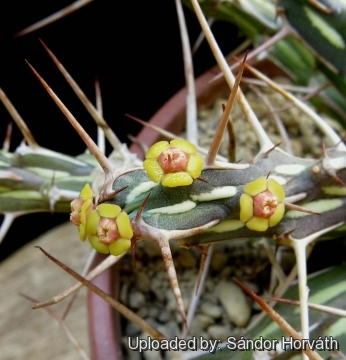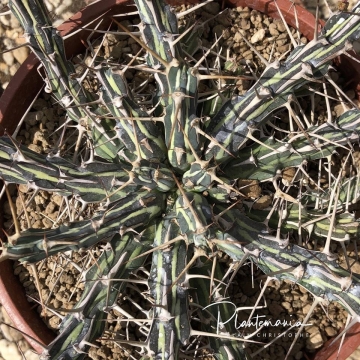




Your support is critical to our success.

Origin and Habitat: Dry southern regions of Ethiopia and the whole Turkana District in Northern Kenya. It is locally common.
Altitude range: 100-1000 metres above sea level.
Habitat and ecology: Euphorbia kalisanaSN|32373]]SN|32373]] grows in variety of habitats such as sandy gravelly soil, rocky slopes and in plain and lava hill. Acacia-Commiphora scrub in sandy alluvium, plain of lava boulders with soft damp mud beneath. Commiphora-Grewia bushland on tan sandy soil.
Synonyms:
- Euphorbia kalisana S.Carter
Description: Euphorbia kalisana is a perennial medusoid succulent euphorbia forming spiny mounds to 1-2 m across, with sprawling cylindrical branches spreading from a thick central stem broader than high. The stems showing dark/light green longitudinal stripes are bears single long spines. The cyathia are yellow. Euphorbia kalisana is strictly related to Euphorbia triaculeata.
Derivation of specific name: The specific name 'kalisana' comes from Kiswahili “kali sana', very sharp, fierce; for the spination, which is an apt description.
Root: Thick, fleshy merging with the stem.
Stem: Main stems short, subterranean, thick to 7.5 tall and 20 cm in diameter, the apex usually at ground-level with spiral tubercles, each axil from the apical growing point producing a persistent, tuberculate, spreading, lateral stem to 1 m long, 20 mm thick, sparsely rebranched when mature, green striped with yellow-green, with shallow tubercles to 4 cm apart in 5 series.
Spine shield: Oblong-triangular, to 2.5 cm long and 1 cm wide, very robust, quite separate.
Spine: Single, very robust, pale grey to 7 cm long.
Stipular spines: Much shorter less than 8 mm long.
Inflorescences (cymes): Solitary, simple. Bracts deltoid, 1.75 × 1.75 mm. Peduncles approx 13 mm long.
Flowers (cyathia): To 3 mm tall and 7,5 mm in diameter, with broadly funnel-shaped involucres. Nectar-gland rectangular, touching, yellow. Male flowers with fan-shaped, dentate bracteoles; stamens c. 5 mm long. Female flower with 2 mm long styles free to the base, apices thickened.
Bibliography: Major references and further lectures
1) Eggli, U., ed. “Illustrated handbook of succulent plants: Dicotyledons”. 2002
2) Urs Eggli, Leonard E. Newton “Etymological Dictionary of Succulent Plant Names” Springer Science & Business Media, 29 June 2013
3) Mark Isaak “Curiosities of Biological Nomenclature” <http://www.curioustaxonomy.net/misc/languages.htm> web 17 January 2017
4) Susan Carter, A. R. Smith “Flora of Tropical East Africa - Euphorbiaceae” Volume 2 CRC Press, 01 June 1988
5) African Plants Database (version 3.4.0). Conservatoire et Jardin botaniques de la Ville de Genève and South African National Biodiversity Institute, Pretoria, "Retrieved 17 January 2017 ", from <http://www.ville-ge.ch/musinfo/bd/cjb/africa/>.
6) Euphorbia kalisana S.Carter in: “Hooker's Icones Plantarum”, Pl. 39: t. 3852 (1982)
7) Susan Carter, “Problems of distinction among succulent Euphorbia species from eastern tropical Africa” Botanical Journal of the Linnean Society. Volume 94, Issue 1-2, pages 67–78, January 1987

Euphorbia kalisana Photo by: Sándor Horváth

Euphorbia kalisana Photo by: © Plantemania
Cultivation and Propagation: This specie has the fame to be quite tricky to cultivate. A very very light and warm place is highly appreciated, but full sun all day long stops the growth, which is not resumed very easily and will lead to the loss of the plant.
It does best in a mineral soil, good drainage is essential. Water sparingly during the summer months and keep dry in winter. In the short growing season it likes ample water and in this period it grows rather quickly, though not for a long time. When not in growth, Euphorbia kalisanaSN|32373]]SN|32373]] is killed right away, when given too much water. It is a slow growing long lived plant and once established, it will be content in its position and with its soil for years. It can tolerate moderate shade, and a plant that has been growing in shade should be slowly hardened off before placing it in full sun as the plant will be severely scorched if moved too suddenly from shade into sun.
Propagation: It is propagated from seed sown during spring or summer. Germination occurs within 3 weeks. Sowing seed of this self fertile species is the surest method of growing typical offspring and seedlings are in the first season relatively easy to grow. It can be reproduced by cuttings or grafting as well but often lateral branches fail to produce the characteristic thick main stem.
| Your Actions | |
|---|---|
| Back to Euphorbia index | |
| Back to Euphorbiaceae index | |
 |
Back to Succulents Encyclopedia index |
Privacy stantement - Terms and conditions - How to cite - About us - Feedback - Donate



